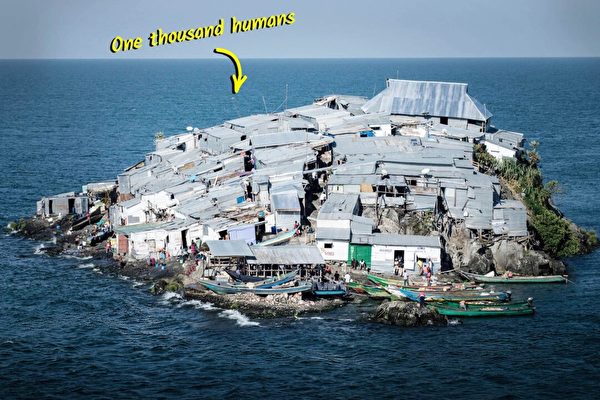In Lake Victoria, the second largest freshwater lake in the world, lies a small island called Migingo Island. Due to the abundant and highly profitable Nile tilapia fish resources, Uganda and Kenya have been continuously vying for sovereignty over Migingo Island, earning it the title of “Africa’s smallest war”.
Migingo Island is a protruding rocky outcrop, smaller than half a football field in size, covered with corrugated iron shacks and surrounded by over 23,000 square miles of water, resembling a armored turtle rising from the lake’s surface. Here, people of different nationalities coexist harmoniously despite facing territorial disputes, fishing competition, and diverse perspectives.
It all began over thirty years ago when reports claimed that the daily income of fishermen on Migingo Island was three to four times that of fishermen on the African continent for a month. The huge profits attracted people in droves, flocking to Migingo Island in search of wealth.
Located on the border of Kenya and Uganda, Migingo Island is rich in highly profitable Nile tilapia fish. This isolated rocky island has thus become a focal point of the sovereignty dispute between the two countries, depending on who you ask. Who benefits from it, who has the right to levy taxes, has become the core of the dispute.
In the initial years of the dispute, starting from 1991 when Migingo Island was still covered with birds, snakes, and weeds, Ugandan police, Kenyan navy, and brave fishermen began setting up tents, building huts, and raising their national flags here. The choice of this location was due to its proximity to deep water areas and abundant fishing resources.
With the increasing demand for Nile tilapia fish (exports now reaching millions of dollars), the population on Migingo Island has also increased, despite the ongoing sovereignty disputes over the island. According to Al Jazeera, it takes only two hours by boat from Kenya to Migingo Island, while it takes eighteen hours from Uganda.
Ultimately, Kenya and Uganda reached a friendly agreement that both countries’ fishermen could fish on Migingo Island. Although the investigation concluded that, as Uganda eventually admitted, Migingo Island belongs to Kenya. The Joint Commission (and Google Maps) also provided ample evidence proving this, with Migingo Island located 510 meters within Kenya’s territory.
The shallow waters where Nile tilapia fish spawn are mostly in Kenya, while the deep waters where fishermen fish are mostly in Uganda. Therefore, currently, Migingo Island is jointly managed by the two countries, striving to recover from Africa’s “smallest war”.
In 2009, the population on Migingo Island was 130 people. Now, reports claim the population on the island ranges from 400 to 1,000 people, making it the most densely populated island on Earth.
Living on a bustling small island means that people of all kinds must accommodate each other in various aspects.
In January, Dubai filmmaker Joe Hattab personally visited the island. He found that the majority are Kenyans and Ugandans on the island, but there are also Tanzanians and Congolese. On disputed land, the community formulates its own laws, residents gather and blend together, and live in harmony. “We are all Africans,” a local official said in Hattab’s film, “the people here are my best friends.”
Residents on Migingo Island are entrepreneurial spirited; where there’s profit to be made, someone will find it. There are supermarkets, pharmacies, bars, brothels, makeshift open-air casinos, hair salons, and fisherman’s scales on the island. It is said that everyone living here has their own business.
Daniel Obadha has been running a barber shop and a mobile charging station on Migingo Island for years. He said, “I love living on Migingo Island,” and added, “Because many customers come not only from Kenya but also from Uganda and Tanzania, there is a lot of business, and I earn more money than on the African continent.” Hattab noted that Migingo Island attracts a diverse population as no visas are required to live there.
Eddison Ouma, a fisherman from Uganda, has lived on Migingo Island for over five years, but due to the long journey, he only visits home twice a year. Ouma said in 2019, “We don’t have jobs; that’s why we fish.” He added that he pays some of his catch to the Ugandan police on the island as a “protection tax.” In 2004, Uganda began dispatching armed police and marine commandos to Migingo to tax fishermen and protect them from pirate attacks.
However, Kenyan fishermen began to complain of harassment by Ugandan officials, including fishing in Ugandan waters. In response, the Kenyan government deployed marine commandos to Migingo Island, nearly leading to conflicts between the two countries.
According to Al Jazeera, in 2019, Kennedy Ochieng from Kenya was accused of fishing in Ugandan waters, and nearly 700 pounds of Nile tilapia fish, fuel, and fish bait he caught were confiscated by Ugandan authorities.
France 24 reported that in recent years, agreements reached by both parties have eased some of the disputes, allowing fishermen from both sides to fish in Ugandan waters. However, venturing too far may still result in confiscation of their catch.
According to Al Jazeera, another party benefiting from Migingo Island is ship leasing companies, profiting by taking 80% of the catch from fishermen leasing their boats.
Regarding the current dispute over Migingo Island: Kenyans uncommonly argue that Nile tilapia fish reproduce in shallower waters in Kenya, thus belonging to them. Ugandans feel entitled to their deep lake, although the island undoubtedly belongs to Kenya. Now jointly managed by both countries, the island strives to recover from Africa’s “smallest war”.
Thus, as governments continue to assert their sovereignty over the exposed islands, fishermen and their wealth still face the question, “How long can we stop them?”

